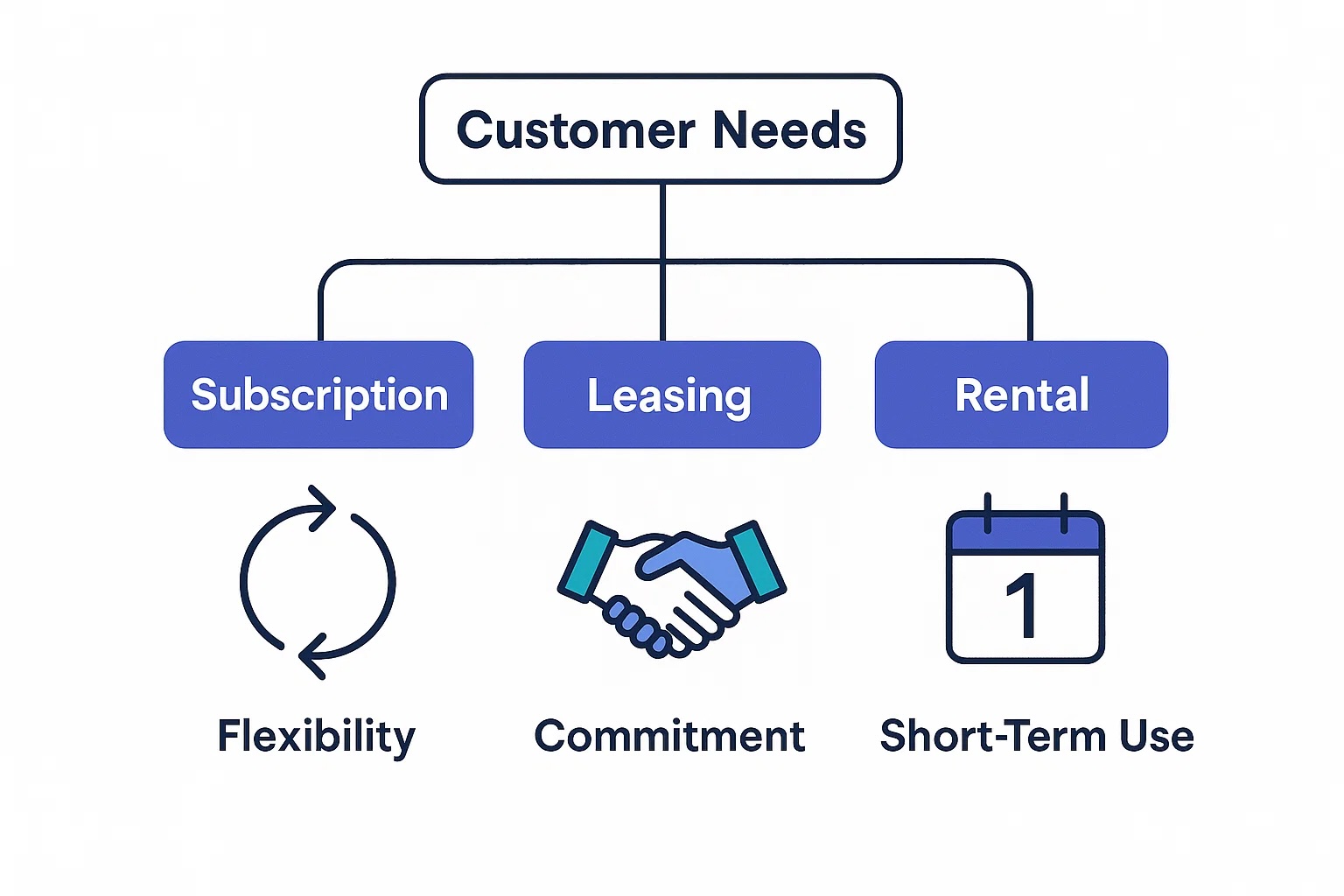Choosing the right mobility solution can feel overwhelming, but understanding the differences is the key to unlocking the perfect fit for your needs.
Key Takeaways
- Car subscriptions, leasing, and rentals each serve different purposes based on customer needs.
- Car subscriptions offer flexibility and an all-inclusive service, ideal for short to medium-term usage with minimal hassle.
- Leasing is suited for those seeking long-term commitments, often providing lower monthly costs but with less flexibility.
- Rental is best for temporary, short-term use, offering straightforward access without long-term requirements.
- Understanding these differences can help you make an informed decision and optimise customer experience or fleet management goals.

The automotive landscape has shifted dramatically over the past decade. Consumer preferences increasingly favour access over ownership, driving what experts call the "usership" trend. Dealerships, OEMs, and mobility operators are experimenting with subscription models, flexible leasing arrangements, and short-term rental options to meet this evolving demand.
Yet despite this innovation, significant confusion persists between these mobility models. This misunderstanding creates barriers to dealer adoption, erodes customer trust, and complicates revenue strategies. For mobility leaders looking to modernise vehicle access, clarity around these distinctions isn't just helpful, it's essential for success.
Understanding the fundamental differences between car subscription, leasing, and rental models will enable you to make informed decisions about which approach best serves your business objectives and customer needs. Each model carries distinct operational requirements, risk profiles, and profit potential that directly impact your bottom line.
Defining the Models: Core Differences That Matter
What Is Car Subscription?
Car subscription represents a comprehensive access model where subscribers pay a single monthly fee for vehicle use alongside bundled services. These services typically include maintenance, insurance, taxes, and roadside assistance, creating an all-inclusive mobility solution.
Contract durations typically range from one to twelve months, offering significantly more flexibility than traditional automotive products. Many subscription services include vehicle swap or upgrade options, allowing subscribers to change vehicles based on seasonal needs or lifestyle changes.
The model is digital-first, often managed through dedicated apps or platforms that handle everything from onboarding to billing. This technological foundation enables real-time fleet management, customer communication, and data analytics that inform business decisions.
Understanding car subscription requires clarity about what it excludes. Car subscription is not simply a shorter lease arrangement. Whilst both models use recurring monthly payments, the underlying risk allocation, service bundling, and customer relationship management differ significantly.
Subscription models are not equivalent to daily or weekly rental services. The operational complexity, technology requirements, and customer lifecycle management create entirely different business propositions.
Car subscription should not be confused with rideshare or carsharing services, which provide access to vehicles for specific trips rather than extended personal use. Similarly, subscription models are not structured like vehicle financing, as subscribers typically do not assume residual value risk.
What Is Leasing?
Leasing involves a long-term contract, typically spanning 24 to 48 months, where the lessee pays for vehicle depreciation and usage. Unlike subscription models, lessees bear responsibility for maintaining their own insurance and often handle maintenance costs unless covered by warranty or separate service packages.
At lease-end, lessees typically have options to purchase the vehicle at a predetermined residual value or return it to the leasing company. This structure creates a clear pathway to ownership whilst providing lower monthly payments compared to financing.
The model requires significant upfront commitment and often includes mileage restrictions, excess wear-and-tear charges, and early termination fees that can create unexpected costs for lessees.
What Is Rental?
Rental services provide very short-term vehicle access, ranging from daily to weekly periods, with some extending to monthly arrangements. Pricing structures often exclude bundled services, requiring users to handle fuel, optional insurance add-ons, and various additional fees separately.
Rental providers optimise operations for high vehicle turnover and short-term servicing, creating business models fundamentally different from subscription or leasing approaches. The focus remains on maximising fleet utilisation through rapid customer cycles rather than building long-term relationships.
Why Dealers Misunderstand or Mislabel These Models
Several factors contribute to widespread confusion within the dealer community, particularly in markets where subscription models are still emerging.
Payment structure overlap creates the most obvious source of confusion. Both leasing and subscription rely on recurring monthly payments, making them appear similar from a customer billing perspective. However, this surface-level similarity obscures fundamental operational differences.
Product positioning adds complexity as established rental companies and leasing divisions enter the subscription market, often adding crossover features that blur traditional boundaries. This convergence can make it challenging to distinguish between genuinely innovative subscription offerings and rebranded existing products.
Many dealers operate with legacy mindsets rooted in established lease and rental models. When subscription services are introduced, they're frequently viewed as variants of existing products rather than distinct business models requiring different approaches to pricing, operations, and customer management.
Ecosystem readiness presents practical barriers to proper implementation. Not every dealer has access to the telematics, digital platforms, or insurance partnerships necessary to deliver genuine subscription services. Without these capabilities, dealers may attempt to replicate subscription offerings using existing infrastructure, resulting in hybrid models that confuse customers and limit profitability.
Regulatory ambiguity compounds these challenges, as subscription services may fall into the same legal categories as rental or lease arrangements depending on jurisdiction. This classification uncertainty can influence how dealers structure and market their offerings.
READ MORE: Why Leasing Companies Are Adopting Car Subscription in 2025
Why Clarity Matters for Your Business
Customer trust and expectations suffer when mobility models are misaligned or poorly communicated. When customers sign up for what they believe is a comprehensive subscription service only to discover unexpected costs or limitations, credibility erodes and adoption rates decline.
Pricing design depends entirely on accurately understanding which risks your business bears. Misclassifying a subscription service as a lease can lead to incorrect cost bundling, resulting in either unprofitable pricing or customer dissatisfaction when hidden costs emerge.
Profit and margin management becomes impossible without clear model definitions. Misclassifying mobility services can lead to inappropriate capital allocations, incorrect depreciation assumptions, and margin leakage that undermines business viability.
Marketing and compliance requirements differ significantly between these models. Rental services face different regulatory obligations than leasing arrangements, and subscription services may fall under entirely separate frameworks. Clarity ensures accurate messaging and regulatory compliance.
Strategic positioning opportunities arise when subscription services are properly differentiated rather than presented as rebranded existing products. A well-defined subscription offering becomes a competitive differentiator that attracts specific customer segments and creates new revenue streams.
Components and Success Factors
Capital and Asset Structure
Subscription providers typically choose between asset-heavy models, where they own fleet vehicles directly, and asset-light approaches that involve acquiring or leasing vehicles from dealers and OEMs. Each approach carries different capital requirements, risk profiles, and scalability characteristics.
Lifecycle strategy decisions determine how long vehicles remain in subscription service before transitioning to remarketing or direct sale channels. These decisions directly impact depreciation assumptions, maintenance costs, and overall profitability.
Operational Technology and Digital Integration
Telematics systems enable mileage monitoring, driver behaviour analysis, and vehicle condition tracking that inform pricing decisions and maintenance scheduling. Without robust telematics capabilities, subscription providers cannot effectively manage fleet utilisation or customer relationships.
Digital contract management, onboarding platforms, and automated billing systems reduce operational overhead whilst improving customer experience. These technological foundations distinguish genuine subscription services from traditional rental or leasing arrangements.
Customer portals that enable service management, vehicle swaps, and account modifications create the flexibility that subscription customers expect. Without these digital touchpoints, providers cannot deliver the convenience that justifies subscription pricing premiums.
Bundling and Cost Management
Comprehensive service bundling typically includes insurance, maintenance, roadside assistance, and vehicle registration within subscription pricing. This bundling creates operational complexity but eliminates the cost uncertainty that makes traditional leasing or rental less attractive to many customers.
Effective bundling requires partnerships with insurance providers, maintenance networks, and service organisations that can deliver consistent quality across geographical markets. Building these partnerships represents a significant operational challenge that many dealers underestimate.
Pricing and Term Structure
Subscription pricing must balance service costs, depreciation, fleet utilisation rates, and profit margins whilst remaining competitive with leasing and financing alternatives. This complex calculation requires sophisticated financial modelling and regular adjustment based on operational experience.
Flexible term structures with mileage bands and upgrade options create the customer value proposition that differentiates subscription from fixed-term leasing. However, this flexibility complicates demand forecasting and fleet planning.
Challenges, Trade-offs, and Risk Factors
Monthly subscription costs typically exceed leasing payments due to comprehensive service bundling and shorter commitment periods. This price premium limits customer adoption and requires clear value communication to justify the additional expense.
Utilisation risk emerges when subscriber demand fluctuates or churn rates exceed projections. Idle vehicles generate costs without revenue, while high churn rates increase customer acquisition expenses and reduce lifetime value.
Maintenance unpredictability and insurance claim exposure create financial risks that traditional leasing arrangements pass to customers. Subscription providers must build financial reserves and operational capabilities to manage these exposures effectively.
Scalability challenges often surprise providers who underestimate the operational complexity of managing diverse customer needs, vehicle maintenance, and remarketing processes simultaneously. Many successful pilots fail to scale profitably due to these operational demands.
Consumer adoption barriers include price sensitivity, limited market awareness, and trust concerns about new business models. Overcoming these barriers requires significant marketing investment and operational excellence that builds customer confidence.
Real-World Applications and Lessons
European providers like Finn have demonstrated successful subscription scaling using multi-OEM fleet strategies that reduce single-brand dependence whilst maximising vehicle variety for customers. Their approach highlights the importance of strategic partnerships and operational flexibility.
Premium OEM pilots have tested subscription models as "mobility door openers" that introduce customers to brands before converting them to traditional purchase or lease arrangements. This strategy treats subscription as a customer acquisition tool rather than a standalone profit centre.
Academic research and industry case studies consistently highlight three critical success factors: accurate demand forecasting, effective customer segmentation, and operational overhead management. Providers who excel in these areas demonstrate sustainable profitability, while those who struggle typically exit the market.

Building Clarity for Competitive Advantage
The confusion between car subscription, leasing, and rental models represents both a challenge and an opportunity for forward-thinking mobility providers. Dealers and OEMs who develop clear understanding and operational excellence in subscription services can capture market share from competitors who continue to blur these distinctions.
Success requires commitment to the technological infrastructure, operational partnerships, and financial modelling that genuine subscription services demand. Half-measures that attempt to replicate subscription benefits using existing infrastructure typically fail to deliver customer value or business profitability.
The mobility landscape will continue evolving as customer preferences shift towards flexible access models. Providers who master the complexities of subscription services today position themselves to lead this transformation, whilst those who remain confused risk obsolescence as customer expectations outpace their capabilities.
Your next step involves honest assessment of your organisation's readiness to deliver genuine subscription services. This means evaluating technology capabilities, partnership networks, financial resources, and operational expertise against the requirements outlined above. Only with this clarity can you determine whether subscription represents a viable growth opportunity or whether focusing on excellence in leasing or rental better serves your strategic objectives.
Want to see how U.S. dealers are already turning aged inventory into recurring revenue? Our white paper, The Subscription Advantage, breaks down why subscription works, the benefits you can expect, and how to start small with a pilot. It’s a practical, no-nonsense guide designed for dealer leadership teams who want to explore new profit channels without overhauling their operations.
Explore Our Latest Insights
Discover trends and innovations in the automotive sector.





